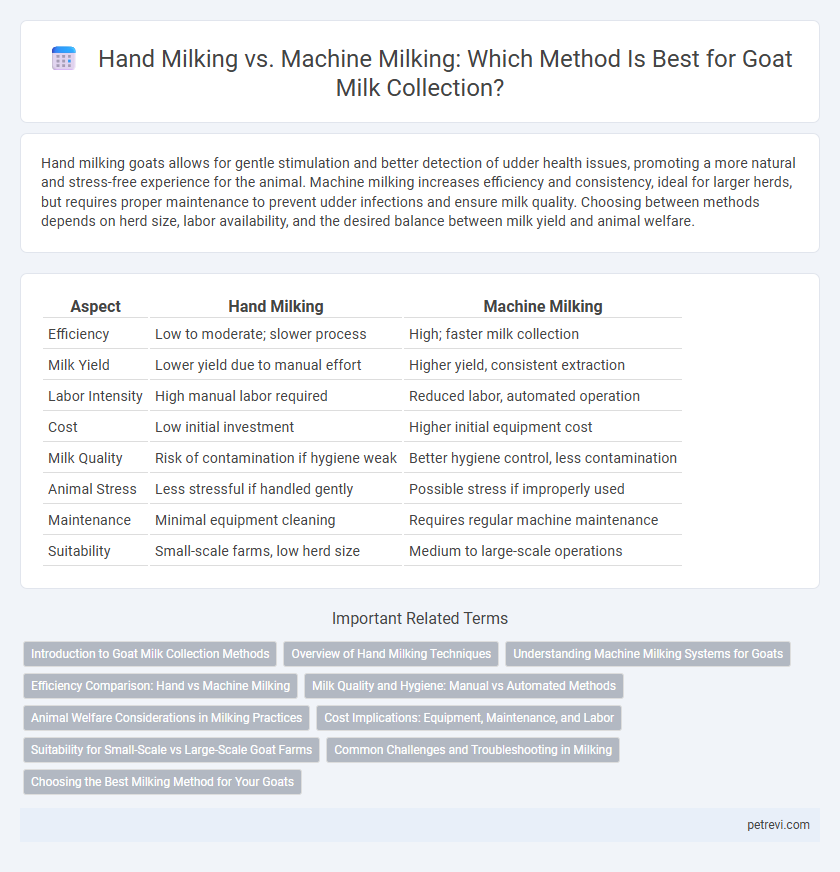Hand milking goats allows for gentle stimulation and better detection of udder health issues, promoting a more natural and stress-free experience for the animal. Machine milking increases efficiency and consistency, ideal for larger herds, but requires proper maintenance to prevent udder infections and ensure milk quality. Choosing between methods depends on herd size, labor availability, and the desired balance between milk yield and animal welfare.
Table of Comparison
| Aspect | Hand Milking | Machine Milking |
|---|---|---|
| Efficiency | Low to moderate; slower process | High; faster milk collection |
| Milk Yield | Lower yield due to manual effort | Higher yield, consistent extraction |
| Labor Intensity | High manual labor required | Reduced labor, automated operation |
| Cost | Low initial investment | Higher initial equipment cost |
| Milk Quality | Risk of contamination if hygiene weak | Better hygiene control, less contamination |
| Animal Stress | Less stressful if handled gently | Possible stress if improperly used |
| Maintenance | Minimal equipment cleaning | Requires regular machine maintenance |
| Suitability | Small-scale farms, low herd size | Medium to large-scale operations |
Introduction to Goat Milk Collection Methods
Hand milking remains a traditional and gentle method for goat milk collection, promoting close animal handling and reducing stress in smaller herds. Machine milking offers increased efficiency and consistent milk flow, ideal for larger goat operations aiming to optimize productivity and hygiene. Each method impacts milk quality, udder health, and overall farm management practices differently, influencing the choice based on herd size and farm goals.
Overview of Hand Milking Techniques
Hand milking techniques for goats involve gentle, rhythmic compression of the teat using the thumb and forefinger to extract milk efficiently without causing stress or injury. Proper hand milking requires maintaining a clean environment and consistent practice to ensure udder health and maximize milk yield. This method benefits small-scale farms by offering control over milking speed and immediate detection of mastitis or other udder issues.
Understanding Machine Milking Systems for Goats
Machine milking systems for goats utilize specialized milking clusters and vacuum pumps designed to accommodate the smaller teat size and milk flow rate of goats, ensuring efficient and hygienic milk extraction. These systems improve milking speed, consistency, and reduce labor compared to hand milking while maintaining milk quality by minimizing contamination risks. Proper maintenance and calibration of the machine settings are critical for preventing teat injuries and ensuring animal welfare during the milking process.
Efficiency Comparison: Hand vs Machine Milking
Machine milking of goats significantly enhances efficiency by reducing milking time to an average of 5-7 minutes per animal, compared to 10-15 minutes with hand milking. Mechanical milking systems ensure consistent milk flow and minimize labor fatigue, allowing the handling of larger herds with fewer workers. Hand milking, while cost-effective for small-scale operations, lacks the speed and uniformity of machine milking, impacting overall productivity and scalability.
Milk Quality and Hygiene: Manual vs Automated Methods
Hand milking goats allows for careful inspection of teats and immediate response to any contamination, often resulting in higher milk quality with lower somatic cell counts due to gentle handling. Machine milking offers consistent milking routines and reduces human contact, minimizing bacterial contamination risk when proper sanitation protocols are followed. Studies indicate that while automated milking systems enhance milking efficiency, maintaining strict hygiene practices is critical to preserving milk quality comparable to manual methods.
Animal Welfare Considerations in Milking Practices
Hand milking goats allows for gentle handling and reduces stress by fostering closer human-animal interaction, which can improve udder health and overall welfare. Machine milking, while efficient, requires appropriate equipment and technique to avoid teat injuries and mastitis, emphasizing the importance of proper maintenance and milking protocols. Ensuring clean, stress-free environments and monitoring animal behavior are critical in both practices to promote goat well-being during milk collection.
Cost Implications: Equipment, Maintenance, and Labor
Hand milking goats requires minimal initial investment with negligible equipment costs limited to buckets and stools, making it cost-effective for small-scale operations. Machine milking demands higher upfront expenses for specialized milking machines and regular maintenance, alongside electricity or fuel costs, but significantly reduces labor hours per milking session. Balancing these costs depends on herd size and production goals, where manual milking suits limited goats, while mechanized systems provide efficiency and scalability despite higher capital outlay.
Suitability for Small-Scale vs Large-Scale Goat Farms
Hand milking is highly suitable for small-scale goat farms due to its low initial investment and gentle handling that reduces stress on animals, ensuring higher milk quality. Machine milking offers efficiency and consistency essential for large-scale operations, significantly increasing collection speed and reducing labor costs. Smallholder farms benefit from traditional hand milking methods while industrial goat dairies rely on mechanized milking systems to optimize productivity and hygiene.
Common Challenges and Troubleshooting in Milking
Hand milking goats often faces challenges such as inconsistent milk flow and increased risk of contamination due to manual handling, requiring careful hygiene practices to maintain milk quality. Machine milking introduces issues like improper vacuum levels and teat cup alignment, which can cause teat injuries and decreased milk yield, demanding regular equipment checks and maintenance. Both methods require monitoring for mastitis symptoms and adapting techniques to individual goat behavior to ensure efficient and safe milk collection.
Choosing the Best Milking Method for Your Goats
Hand milking offers precise control and is ideal for small-scale goat milk collection, promoting animal comfort and reducing stress. Machine milking increases efficiency and consistency, making it suitable for larger herds but requires proper equipment maintenance to ensure milk hygiene. Understanding herd size, budget, and goat temperament helps determine the best milking method for optimal milk yield and quality.
Hand milking vs Machine milking for Goat milk collection Infographic

 petrevi.com
petrevi.com